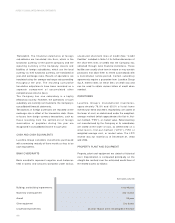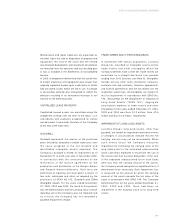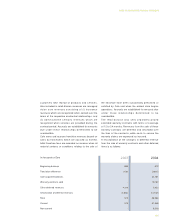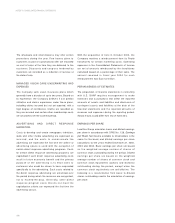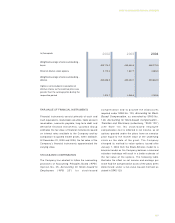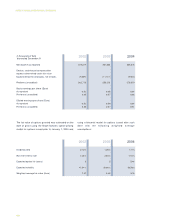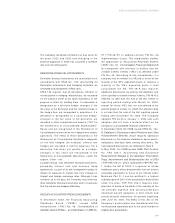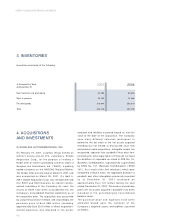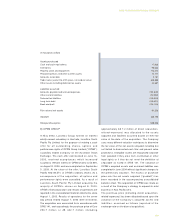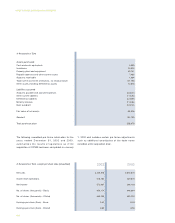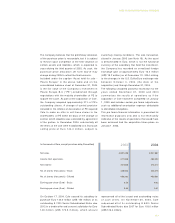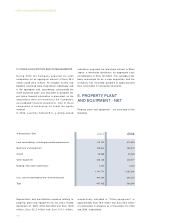LensCrafters 2004 Annual Report Download - page 110
Download and view the complete annual report
Please find page 110 of the 2004 LensCrafters annual report below. You can navigate through the pages in the report by either clicking on the pages listed below, or by using the keyword search tool below to find specific information within the annual report.NOTES TO CONSOLIDATED FINANCIAL STATEMENTS
109
The Company recognizes forfeitures as they occur for
the years 2002 and 2003 and changing to the
binomial approach in 2004 has assumed a forfeiture
rate of 6% for 2004 grants.
DERIVATIVE FINANCIAL INSTRUMENTS
Derivative financial instruments are accounted for in
accordance with SFAS No. 133, Accounting for
Derivative Instruments and Hedging Activities, as
amended and interpreted (“SFAS 133”).
SFAS 133 requires that all derivatives, whether or
not designed in hedging relationships, be recorded
on the balance sheet at fair value regardless of the
purpose or intent for holding them. If a derivative is
designated as a fair-value hedge, changes in the
fair value of the derivative and the related change in
the hedge item are recognized in operations. If a
derivative is designated as a cash-flow hedge,
changes in the fair value of the derivative are
recorded in other comprehensive income (“OCI”) in
the Statements of Consolidated Shareholders’
Equity and are recognized in the Statements of
Consolidated Income when the hedged item affects
operations. The effect of these derivatives in the
Statements of Consolidated Operations depends
on the item hedged (for example, interest rate
hedges are recorded in interest expense). For a
derivative that does not qualify as a hedge,
changes in fair value are recognized in the
Statements of Consolidated Operations, under the
caption “Other - net”.
Luxottica Group uses derivative financial instruments,
principally interest rate and currency swap
agreements, as part of its risk management policy to
reduce its exposure to market risks from changes in
interest and foreign exchange rates. Although it has
not done so in the past, the Company may enter into
other derivative financial instruments when it assesses
that the risk can be hedged effectively.
RECENT ACCOUNTING PRONOUNCEMENTS
In December 2003, the Financial Accounting
Standards Board (“FASB”) issued FASB
Interpretation (“FIN”) No. 46, Consolidation of
Variable Interest Entities - an interpretation of ARB No.
51 (“FIN 46-R”) to address certain FIN No. 46
implementation issues. This interpretation clarifies
the application of Accounting Research Bulletin
(“ARB”) No. 51, Consolidated Financial Statements
for companies with interests in entities that are
variable interest entities (“VIEs”) as defined under
FIN No. 46. According to this interpretation, if a
company has an interest in a VIE and is at risk for the
majority of the VIE’s expected losses or receives a
majority of the VIE’s expected gains it shall
consolidate the VIE. FIN 46-R also requires
additional disclosures by primary beneficiaries and
other significant variable interest holders. FIN 46-R is
effective no later than the end of the first interim or
reporting period ending after March 15, 2004,
except for those VIEs that are considered to be
special purpose entities for which the effective date
is no later than the end of the first reporting period
ending after December 15, 2003. The Company
adopted FIN 46-R on January 1, 2004 and such
adoption did not have a material effect on the
Company’s consolidated financial statements.
In December 2003, the FASB issued SFAS No. 132-
R, Employer’s Disclosures about Pensions and Other
Postretirement Benefits, which requires additional
disclosures in the financial statements about assets,
obligations, and cash flows among other items. The
new required disclosures are reflected in Note 9.
In May 2004, the FASB issued FASB Staff Position
No. FAS 106-2, Accounting and Disclosure
Requirements Related to the Medicare Prescription
Drug, Improvement and Modernization Act of 2003
(“FSP FAS 106-2”), which supersedes FSP FAS 106-
1. Under the Act of 2003, if a sponsor of retiree
healthcare plans offers drug benefits that are at least
actuarially equivalent to those to be offered under
Medicare Part D, it can be entitled to a federal
subsidy equal to 28% of the prescription drug claims
under the plan. FSP FAS 106-2 requires plan
sponsors to disclose the effect of the subsidy on the
net periodic expense and accumulated post
retirement benefit obligation in their interim and
annual financial statements for periods beginning
after June 15, 2004. The effect of this Act on the
Company’s current plans was immaterial and thus
not disclosed separately due to the small number of
eligible plan participants.





